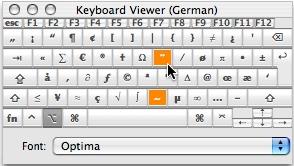

Since most OS installations are used in one region only this menu is off by default, but can be enabled by going to the Language & Text (or International) system preferences, selecting the Input Sources tab, and checking the box next to "Show Input menu in menu bar." Next be sure to check the options to include the keyboard and character viewers in the menu, and you should then be able to access both from the new input menu in the right of the menu bar. This menu is primarily used for switching keyboard layouts for different languages, but can also be used to access both the keyboard layout viewer and the character palette. This menu will be available in most applications, especially those that have input options for text, and at the bottom of this menu will be a "Special Characters." entry that will bring up the character palette when clicked.Ī second option for the character palette is to use the OS X input menu. The most straightforward way to access the character palette is to use the Edit menu in OS X. If you would like to use the OS X character viewer, it can be accessed in a few different ways: The Character Viewer palette allows you to access numerous unicode characters. Having these characters in the character palette makes managing them far easier than prior approaches in which unique symbol and dingbat fonts had to be used. Not only can you use fun items like emoticons, but you can also enhance writing with scientific and mathematical symbols, foreign script characters, symbols, and even Braille. usr/share/fonts/truetype/noto/NotoSerifKannada-Regular.The OS X character palette is a convenient option for accessing multiple unicode symbols that are part of modern font collections. usr/share/fonts/truetype/noto/NotoSerifKannada-Bold.ttf usr/share/fonts/truetype/noto/NotoSansKannadaUI-Regular.ttf usr/share/fonts/truetype/noto/NotoSansKannadaUI-Bold.ttf usr/share/fonts/truetype/noto/NotoSansKannada-Regular.ttf usr/share/fonts/truetype/noto/NotoSansKannada-Bold.ttf usr/share/fonts/truetype/lohit-kannada/Lohit-Kannada.ttf usr/share/fonts/truetype/Navilu/Navilu.ttf usr/share/fonts/truetype/Gubbi/Gubbi.ttf Run the script with either python find_fonts.py ಠ or python3 find_fonts.py ಠ replacing ಠ with the character you care about.Įxample output: $ python3 find_fonts.py ಠ."""Finds fonts containing the (Unicode) character c."""Ĭhar = code('utf-8') if isinstance(search, bytes) else search
#Mac os character map viwer code#
Save the following code into a file called (say) find_fonts.py:
#Mac os character map viwer install#
Install either the python-fontconfig or the python3-fontconfig package (or both), depending on whether you prefer to use Python 2 or Python 3. usr/share/fonts/truetype/noto/NotoSerifKannada-Bold.ttf: Noto Serif Kannada:style=Boldįor specific characters, I asked a similar question on “Ask Different” copying here the Python script that I ended up using (it works on both operating systems).

usr/share/fonts/truetype/Gubbi/Gubbi.ttf: Gubbi:style=Normal usr/share/fonts/truetype/lohit-kannada/Lohit-Kannada.ttf: Lohit Kannada:style=Regular usr/share/fonts/truetype/noto/NotoSansKannada-Regular.ttf: Noto Sans Kannada:style=Regular

usr/share/fonts/truetype/Navilu/Navilu.ttf: Navilu:style=Normal usr/share/fonts/truetype/noto/NotoSerifKannada-Regular.ttf: Noto Serif Kannada:style=Regular usr/share/fonts/truetype/noto/NotoSansKannadaUI-Bold.ttf: Noto Sans Kannada UI:style=Bold usr/share/fonts/truetype/noto/NotoSansKannada-Bold.ttf: Noto Sans Kannada:style=Bold usr/share/fonts/truetype/noto/NotoSansKannadaUI-Regular.ttf: Noto Sans Kannada UI:style=Regular

If one cares about a language in general rather than a specific character, is to use fc-list with :lang, for example: ~% fc-list :lang=kn-in Since I originally asked this question in 2011, the information has become more difficult to find on both Ubuntu (where the previously recommended FontMatrix no longer seems to have the feature) and on macOS.


 0 kommentar(er)
0 kommentar(er)
